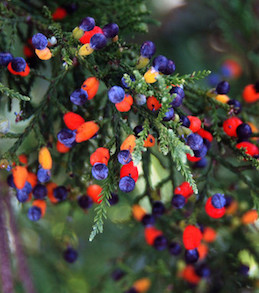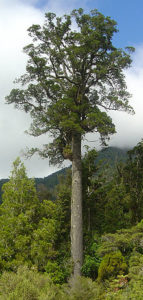The mighty kahikatea
DID YOU KNOW the oldest tree we have at Living Springs is over 800 years old! Kahikatea is New Zealand’s tallest indigenous tree, sometimes reaching 65 metres in height. The trunks have a long slender appearance topped by a smallish ragged crown. In autumn, numerous forest birds feed on its abundant red berries.
Before humans arrived, pure kahikatea forest grew on the wet areas beside our lakes and swamps. Kahikatea also covered extensive areas on the great floodplains. The river channels often changed their course, destroying existing vegetation and exposing new areas for kahikatea to grow on. As sites became drier, other trees such as totara, matai, rimu and hardwoods like tawa replaced the pure kahikatea forests.
With Maori settlement, the forested landscape was changed as areas were burnt off and cleared to grow food. When European settlers arrived in the 1860s, the lowlands were mostly covered by bracken and manuka between large expanses of swamp and bog. However, even back then there were still tens of thousands of hectares of kahikatea forest.
In 1882, refrigerated shipping was developed, and there was a sudden demand for millions of boxes for the butter and cheese being produced by the country’s newly created dairy farms. Kahikatea’s soft, pale, odourless wood was perfect for these boxes, as it did not taint the products in the long journey to Britain. All around the country, there was a renewed frenzy to fell and mill these primordial giants. The kahikatea forests were thus set on a one-way trajectory of destruction; in the 8 years between 1909 and 1917 alone, the remains of kahikatea were reduced by 63 per cent.
Some facts, the Kahikatea:
- is one of ten tall native conifers (includes kauri, tanekaha, rimu, and matai)
- grows rapidly on fertile damp soil, but more tolerant of waterlogged, swampy soils than most native trees
- develops large buttresses (flared trunks at the base of the tree) to support them on wet ground
- has long, narrow and slightly curved leaves with pointed tips on young trees. Adult trees have leaves that are shorter and overlap like fish scales
- is a species with separate male and female trees. Male trees produce pollen in tiny cones. Females produce purple/black seeds that sit on a bright orange or red fruit-like base. These seeds are eaten by birds and other animals
- can produce several million viable seeds in a good year, if the tree is large
- seedlings grow best in well-lit situations
- can live for over 500 years and grow trunks up to 2 m across
- have young trees shaped like Christmas trees and mature trees with tall bare trunks ending with massive shaggy canopies.



The long-term vision of Living Springs is to create an Ecosanctuary on the property and we are off to a good start, with over 13,000 native plants added to the already existing native flora and fauna. Donate now to help us buy and plant more trees or set out yet another trap to catch the pests.